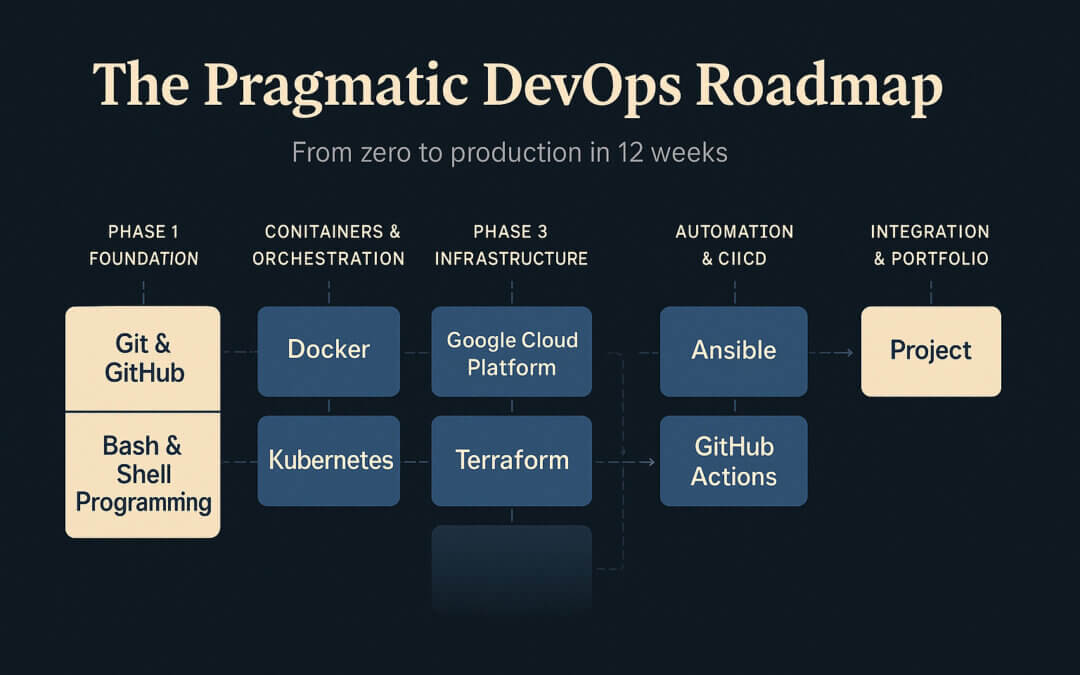A focused learning path for mastering modern DevOps tools like Docker, Kubernetes, Terraform, and GCP – without getting lost in tool overload.
🌍 Why This Roadmap?
If you’ve ever felt overwhelmed by the endless stream of DevOps tools, you’re not alone. While the ecosystem keeps growing, the truth is: you don’t need to learn everything. You just need to learn the right things well.
This roadmap is designed around the 80/20 principle:
Learn the 20% of tools and workflows that give you 80% of real-world value – and jobs.
🎯 The Goal
Within 6 to 12 weeks, you’ll build practical experience with a core set of technologies used in real DevOps and Cloud Engineer roles:
- ✅ Docker (for containerization)
- ✅ Kubernetes (for orchestration)
- ✅ Google Cloud Platform (for infrastructure)
- ✅ Terraform (for infrastructure as code)
- ✅ Ansible (for configuration automation)
- ✅ Git & GitHub (for version control & CI/CD)
- ✅ Bash (for scripting and glue)
By the end, you’ll have a portfolio-ready project, hands-on skills, and confidence in the DevOps job market.
✅ Phase 1: The Foundation (Weeks 1–2)
🔹 1. Git & GitHub – Version Control Essentials
Learn how to track changes, collaborate, and manage code.
- Commands:
git init,clone,commit,branch,merge,push - Set up and use GitHub repositories
🧪 Mini project: Create a GitHub repo for a simple shell tool. Practice branches, PRs, and issues.
🔹 2. Bash & Shell Scripting – Your DevOps Superpower
You can’t automate what you can’t script. Bash is your glue between all tools.
- Basics: variables, conditionals, loops, functions
- Tools:
awk,sed,grep, pipes, redirects - Best practices for writing robust shell scripts
🧪 Mini project: Write a script that scans a directory, logs all file sizes, and compresses old files.
✅ Phase 2: Containers & Orchestration (Weeks 3–5)
🔹 3. Docker – Containerize All the Things
Docker is still the backbone of local development and CI workflows.
- Write
Dockerfiles, build and run containers - Understand volumes, ports, networks, and Docker Compose
- Debug containers and build custom images
🧪 Project: Package a simple web app and a database using Docker Compose for local development.
🔹 4. Kubernetes – The Orchestrator in Action
Master the fundamentals of deploying and managing containerized apps at scale.
- Tools:
kubectl, Minikube/Kind for local clusters - Concepts: Pods, Deployments, Services, Ingress, ConfigMaps, Secrets
- Understand namespaces, contexts, and rolling updates
🧪 Project: Deploy your Dockerized web app into a local Kubernetes cluster.
✅ Phase 3: Infrastructure & Cloud (Weeks 6–8)
🔹 5. Google Cloud Platform – Build Real Cloud Infrastructure
Google Cloud offers one of the best managed Kubernetes services: GKE (Google Kubernetes Engine).
- Set up a GCP project and billing account
- Use GKE to launch and scale Kubernetes clusters
- Understand IAM, VPCs, and Cloud Console basics
- Use the
gcloudCLI
🧪 Project: Deploy your app to GKE with a custom domain and static IP.
🔹 6. Terraform – Infrastructure as Code
Terraform lets you automate your entire GCP infrastructure in a reproducible way.
- Basics: Providers, Resources, Variables, Outputs, State
- Define GKE clusters, VPCs, and firewall rules as code
- Learn
terraform plan,apply,destroy
🧪 Project: Provision a full GKE environment using Terraform, including autoscaling, networking, and IAM roles.
✅ Phase 4: Automation & CI/CD (Weeks 9–10)
🔹 7. Ansible – Configuration Management Made Easy
Ansible is great for server provisioning, SSH automation, and legacy system support.
- Write Playbooks, manage Inventories
- Use roles, templates, and variables
- Automate post-deployment tasks
🧪 Project: Provision a virtual machine and configure NGINX and firewall rules with Ansible.
🔹 8. GitHub Actions – Simple CI/CD
Automate your workflow with GitHub-native CI/CD pipelines.
- Write
.ymlworkflows for builds, tests, and deployments - Use secrets and environment variables
- Trigger builds on push, PRs, tags
🧪 Project: Build and push a Docker image from your GitHub repo, and auto-deploy it to GKE on merge.
🔚 Phase 5: Integration & Portfolio (Ongoing)
This is where you pull everything together into a public, professional DevOps project:
- Structure your GitHub repo clearly
- Include a
README.mdin English and optionally German - Use a real-world app (even a simple Flask or Node.js app)
- Combine:
- Dockerfile
- Terraform setup for GKE
- Kubernetes manifests or Helm charts
- GitHub Actions for CI/CD
- Ansible playbook for related server setup
💡 Pro tip: Blog about your process. Share your learnings. Recruiters love seeing initiative + clarity.
📌 Final Thoughts
The best DevOps engineers aren’t the ones who know the most tools.
They’re the ones who know how to build something real with just a few.
This roadmap is built for focus, not perfection. You don’t need to learn 30 DevOps tools – just the 5–7 that power 90% of production systems today.

